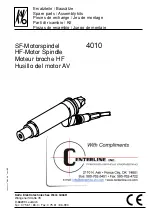
11
Charging Safety
• Please check the data marked on the rating plate of the battery charger. Be sure to
connect the battery charger to a power supply with the voltage marked on the rating
plate. Never connect it to a different mains voltage.
• Protect the battery charger and its cable from damage and sharp edges. Have
damaged cables repaired without delay by a qualified electrician.
• Do not use damaged battery chargers.
• In heavy use the battery pack will become warm. Allow the battery pack to cool to
room temperature before commencing with the charging.
• Do not over-charge batteries. Do not exceed the maximum charging times. These
charging times only apply to discharged batteries. Frequent insertion of a charged or
partly charged battery pack will result in over-charging and cell damage. Do not leave
batteries in the charger for days on end.
• Never use or charge batteries if you suspect that the last time they were charged was
more than 12 months previously. There is a high probability that the battery
pack has already suffered dangerous damage (exhaustive discharge).
• Charging batteries at a temperature below 10°C will cause chemical damage to the cell
and may cause a fire.
• Do not use batteries which have heated during the charging process, as the battery
cells may have suffered dangerous damage.
• Do not use batteries which have suffered curvature or deformation during the charging
process or which show other non-typical symptoms (gassing, hissing, cracking…).
• Never fully discharge the battery pack (recommended depth of discharge max. 80%)
A complete discharge of the battery pack will lead to premature ageing of
the battery cells.
Safety instructions for charge and charging process
!
Flexisharp instructions.indd 11
11/07/2018 13:24






































